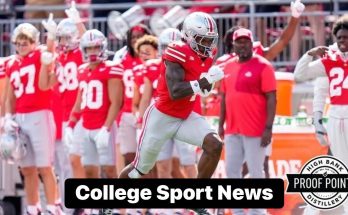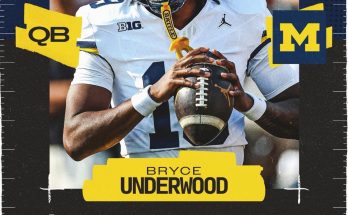Arch Manning Shines at the Half: 180 Yards, 4 TDs, and a 207.3 QBR Despite 1 Costly Pick
When the Manning name is mentioned in football circles, it comes with a weight of history, legacy, and expectation that few families in sports can rival. From Archie Manning’s early days as a collegiate and professional quarterback to Peyton and Eli Manning’s Super Bowl triumphs and Hall of Fame-worthy careers, the Manning name has been tied to excellence under center. Now, Arch Manning, the latest in the line, is beginning to carve out his own story. At halftime of a pivotal game, his stat line tells a story of brilliance mixed with a reminder that football greatness always comes with challenges. Completing 11 of 18 passes for 180 yards, throwing 4 touchdowns, and earning a remarkable 207.3 QBR, Arch dazzled in just two quarters of play. Yet, one interception also stands out, reminding fans and analysts that the journey of growth and leadership is as much about resilience as it is about numbers.
The first half performance from Arch Manning is significant not just for the raw statistics but for what it reveals about his poise, maturity, and ability to command the field. Throwing four touchdowns in a single half is no small feat, particularly at the collegiate level where defenses are fast, schemes are complex, and every mistake is magnified under national scrutiny. His 207.3 QBR at halftime reflects near-perfect execution, efficiency in decision-making, and the ability to maximize opportunities when they present themselves. For fans watching, there was a sense of witnessing the birth of another Manning-era quarterback, one who may soon join his uncles in the pantheon of household football names.
Breaking down the performance, Arch showed a remarkable combination of arm strength, touch, and field awareness. The 180 passing yards were not padded with simple short completions; they came with precision strikes downfield, throws into tight windows, and quick decisions under pressure. This kind of performance at the half sends a message that defenses cannot afford to relax against him, even if they manage to rattle him with pressure or disguise their coverages. His composure in the pocket, stepping up when rushers closed in and keeping his eyes downfield, mirrored some of the qualities that made Peyton Manning legendary. Yet, unlike his uncles, Arch carries a slightly different style. He combines traditional pocket passing with mobility, the ability to extend plays, and a natural creativity when forced outside of structure. This versatility is increasingly valuable in today’s college game and could make him a highly adaptable quarterback at the next level.
The one blemish on his stat sheet, the interception, should not be overlooked but rather placed in context. Quarterbacks at every level throw picks, but the most important part is how they respond. In Manning’s case, he rebounded with resilience. Following the interception, instead of retreating into conservative play, he attacked again and strung together scoring drives that ended in touchdowns. This kind of mental toughness is exactly what coaches and evaluators look for, and it further establishes his potential as a leader who can handle adversity. Great quarterbacks are not measured by the absence of mistakes but by their response when mistakes happen. Manning’s ability to shake off that error and deliver four scoring throws afterward speaks volumes about his mindset and competitiveness.
Statistically speaking, a QBR of 207.3 at halftime is eye-popping. It indicates near-flawless efficiency, a balance between explosive plays and smart decision-making. In practical terms, it means that nearly every possession with Manning under center in the first half ended in productive yardage or points. The precision of his 11 completions on 18 attempts is particularly impressive because they were not merely safe throws; they carried risk, ambition, and execution. Quarterbacks at his age often struggle with accuracy when pushing the ball downfield, but Manning is already showing an advanced ability to deliver with consistency.
The broader implications of this performance go beyond just one game. Arch Manning has been the subject of enormous attention since high school, where his recruitment was one of the most highly publicized in modern football history. As the nephew of Peyton and Eli, and the grandson of Archie, he was labeled as the next great Manning quarterback before he even threw a collegiate pass. That kind of attention can be suffocating for a young athlete, but Arch appears to be growing into the role with confidence rather than shrinking from it. Performances like this, even if only at halftime, reinforce the notion that the hype around him is not misplaced. He is not just benefiting from his last name; he is demonstrating that he can live up to it.
For Texas fans, who have invested hopes and dreams into Manning as a potential program-transforming quarterback, this kind of showing is particularly significant. The Longhorns have long sought stability at the quarterback position, someone who could restore them to national championship contention. While the program has had talented passers in recent years, Manning’s pedigree and raw ability represent something different—a return to the national spotlight with a quarterback who can carry the weight of the brand. The halftime performance was not just exciting in isolation; it was a statement that the Longhorns might truly be on the cusp of returning to elite status if Arch continues to progress.
Defenses facing Manning will certainly adjust, and the second half of games often presents a different challenge as coordinators scheme to shut him down. But the fact that he was able to accomplish so much in just two quarters speaks to his ability to seize control of a game early. His 4 touchdowns by halftime created a cushion for his team, forced the opposing defense into desperation, and gave his own defense the breathing room to play aggressively. In modern football, momentum can swing on a single possession, and Manning’s ability to put up points quickly provides Texas with a weapon few teams can match.
Beyond the numbers, there is also the intangible element of how Arch commands the field. Reports from practice and the sidelines describe him as calm, confident, and focused. These traits are essential for a quarterback leading a team under the bright lights of college football’s biggest stage. Fans who grew up watching Peyton dissect defenses with surgical precision or Eli calmly guide the Giants to Super Bowl wins are beginning to see shades of that composure in Arch. Yet, he is carving his own identity, not just copying the family template. This individuality, combined with the Manning DNA, could make him a unique blend of old-school fundamentals and new-school adaptability.
One of the most fascinating aspects of this moment is how it fits into the larger narrative of quarterback development in college football today. With the transfer portal, NIL deals, and heightened national attention, quarterbacks are under more pressure than ever to perform immediately. Arch Manning, unlike many of his peers, did not rush into the spotlight unprepared. He took his time developing, learning behind the scenes, and gradually stepping into bigger roles. Now, when his number is called, he looks ready for the responsibility. That patience and long-term development could end up being a defining difference between him and other highly touted recruits who flame out under pressure.
For analysts, the halftime stat line offers a glimpse into what might be a defining season. If Manning continues to post numbers like these, conversations about Heisman candidacy will inevitably surface. More importantly, NFL scouts will be paying close attention. The ability to produce under pressure, to throw multiple touchdowns in a short window of time, and to recover from mistakes are all qualities that translate to the professional level. Manning’s journey is still in its early stages, but nights like this make it clear that he is not just another college quarterback with a famous name. He is a talent in his own right, capable of shaping games and perhaps even redefining Texas football.
As the game moves into the second half, the focus will shift to consistency. Can Arch maintain this level of play across four quarters? Can he adapt when defenses adjust and take away his first reads? Can he manage the game if asked to play conservatively with a lead? These are the questions that define great quarterbacks, and the answers will come with time. But for now, his first-half performance is more than enough to spark excitement. It represents both a glimpse of the future and a reaffirmation that the Manning legacy is alive and thriving in the next generation.
Football is a game of stories as much as statistics, and Arch Manning is writing one that will be closely followed for years to come. The halftime numbers—180 yards, 4 touchdowns, a 207.3 QBR, and a single interception—are more than just data points; they are symbols of potential, resilience, and brilliance under pressure. They remind fans why they watch the game, why they invest emotionally in young players, and why the Manning name still carries such weight in football. Whether he goes on to lead Texas to a win in this particular contest or faces second-half challenges, the memory of this first-half explosion will endure. It marks a milestone in Arch Manning’s journey, one that suggests the future of quarterback play is in good hands.
At the end of the day, one half of football does not define a career. But moments like this accumulate, building a narrative, inspiring teammates, and capturing the imagination of fans. Arch Manning may be the grandson, nephew, and heir to a football dynasty, but with performances like this, he is proving that his story is uniquely his own.



